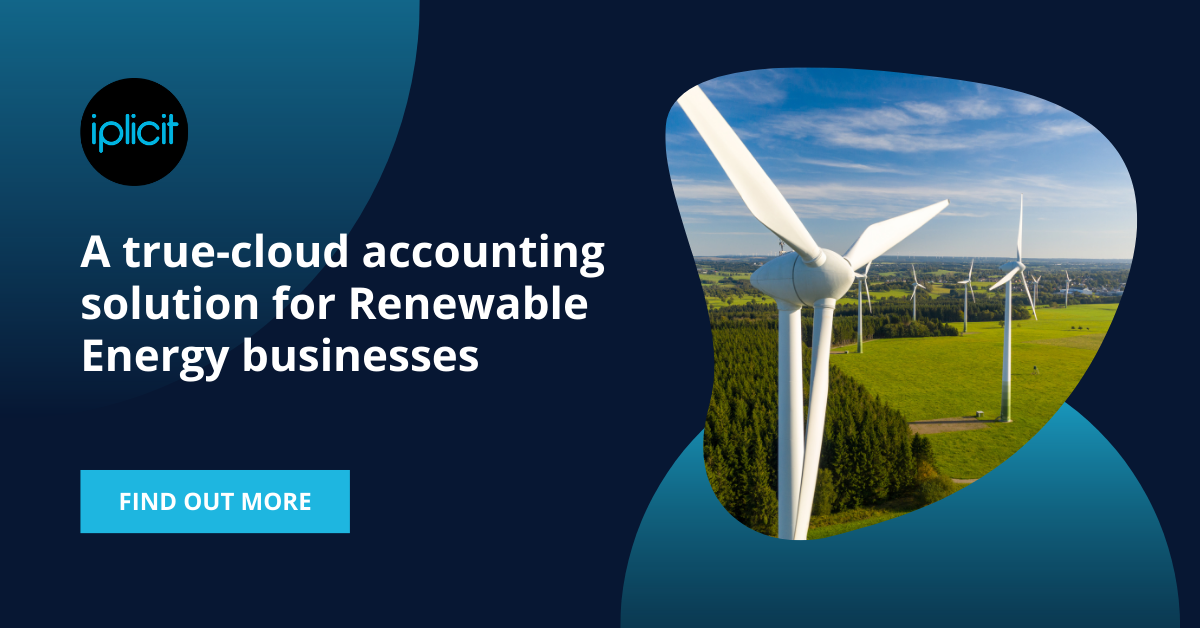It’s vital that the renewable energy sector expands rapidly and thrives if the world is to end its dangerous addiction to fossil fuels.
There are some encouraging statistics to show that this is happening. The UK saw a record amount of energy generated from renewable sources in 2022, according to analysis by Imperial College London.
Yet the International Energy Agency has warned that the world must double its current rate of transition to renewables if it is to stand a chance of achieving net zero carbon by 2050.
One factor that can make expansion unnecessarily complicated for renewable energy businesses is that running their finances can be painfully difficult. An industry that will shape the future can be hampered by technology when it comes to accounting.
Why accounting for renewable energy businesses gets so complicated
The well-known entry-level accounting software packages tend not to work well for a renewable energy business. That’s because most renewable energy businesses usually need to set up their operations as multiple legal entities from an early stage.
Typically, a renewable energy business will create several trading entities, and then set up a special purpose vehicle (SPV) for each of their generating sites. Within each SPV, they might have multiple projects and locations to account for.
Bringing together the financial data from all these entities and consolidating it into meaningful, accurate management information is too much for basic software. That leaves the finance team with no option but to manually key data into spreadsheets and do complex calculations to produce financial reports. Those reports will already be out of date when they are created.
Renewable energy companies will also have a lot of transactions to enter into the system. That adds another layer of complication when it comes to consolidating the accounts and apportioning costs and receipts to the right legal entity or SPV.
How to find the right accounting software for a renewable energy business
Accounting software can make it much easier to handle the finances of your renewable energy company – and make the results that come out of the process more useful.
But the entry-level systems designed for small and start-up businesses won’t do the job, so it’s important to ask the right questions while researching the alternatives:
-
What can be automated? The most useful software will do away with large amounts of data entry and duplicated effort. Much of your accounts payable process will be automated, with invoices matched to purchase orders and the records stored alongside the line item in the system. Bank reconciliation should be greatly simplified, with the system importing data from your bank feed and matching it with the general ledger.
Automation should make life easier for non-finance staff too. Approval workflow automation should ensure the correct budget holders can sign off on spending wherever they are. Expenses apps can allow staff to submit their claims from mobile devices, to be reviewed and authorised promptly. -
How does it handle intercompany transactions? This is where the needs of renewable energy companies really outstrip the capabilities of entry-level software. Only a more powerful system can automatically apportion income and payments to the right parts of the business, making all the necessary intercompany adjustments for you. Complications such as multiple currencies, prepayments and accruals should be easily smoothed out. The software can then strip out intercompany transactions to produce accurate, real-time financial reports, in the right format for whoever needs to see them.
- Does it integrate with other systems? You will probably have your preferred software for recording energy use, customer relations management (CRM) and other key functions. A finance system with an open application programming interface (API) will be able to integrate easily with any other system in the business. Similarly, a plug-in to integrate with Excel or Power BI will ensure data exported to those applications will remain up-to-date when you go back to it.
- What kind of visibility will it give you? Software that handles multi-entity accounting well should offer you complete visibility of your organisation’s books. It should be possible to go from a big-picture view of the business to a close-up look at any transaction within any entity’s accounts, without logging out and back in. There should be the flexibility to report in the different ways that might be needed for different audiences.
- How scalable is it? To scale your business at the rate the drive to Net Zero demands, you will need software that allows you to easily add new legal entities, SPVs and projects, without having to refer back to the software vendor for help.
How accounting software can drive success in renewable energy
Choose the right software and you can help set up your energy business for escalating success driven by high quality management information.
With the most laborious accounting tasks automated, there should be no need for decision makers to wait for the outcome of a lengthy month-end process before they can see financial data. Instead, figures should be meaningful and accurate up to the minute whenever you look at them. That makes for the effective decisions the business will rely on.
Learn more
Find out more about how iplicit can help renewable energy businesses with SPV accounting, contact us for a demonstration.

